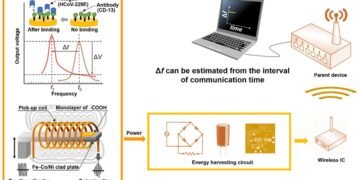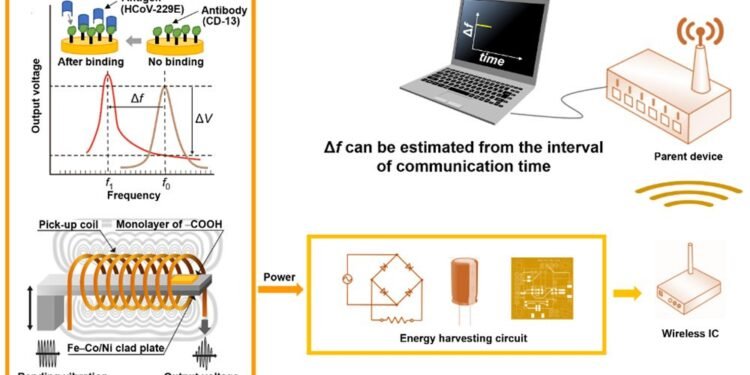What if you could know if your environment contains particles or droplets of COVID-19 as soon as they or you enter the environment? A collaborative research team has developed an independent tool that brings this closer to reality, A battery-free airborne coronavirus detection device.
The device, which does not require a battery, uses a magnetostrictive plate that contains iron, cobalt and nickel, and generates energy by alternating magnetism caused by vibration. The resonance frequency of the Fe-Co/Ni plate, which is used by the host protein of the coronaviruses to enter our cells, changes when the virus is injected, indicating the presence of COVID-19 in the air.
“We know that the resonant frequency changes when the weight of the magnetostrictive material hanges, but we investigated whether this is also the case when the virus is concentrated and whether this is detected,” said Fumio Narita. . study and professor at the Graduate School of Environmental Studies, Tohoku University.
To answer these questions, Fumio and his team must first develop a highly efficient magnetostrictive sensing system that can operate without batteries and transmit information over the air.
They replaced the 0.2mm thick Fe-Co/Ni plate with a rectifier/protection circuit that receives power from bending vibrations and powers the air circulation. The plate transmits the signal and the power obtained from the noise is bent at 115 Hz or 116 Hz. The change in the weight of the plate affects the resonant frequency and changes the transmission time, which means that it can detect anything that sticks to the body plate.
Next, the team developed a biorecognition layer, choosing to focus on the human coronavirus 229E (HCoV-229E) – one of the seven types of coronavirus that affect humans. They immersed the plate in the CD13 protein solution and performed a diagnostic test. When the plate is bent, the resonant frequency decreases as the absorption of HCoV-229, testing whether the charged energy can transmit the detection of the virus as a signal.
Narita added, “We can confirm that the magnetostrictive material can detect the virus and transmit this detection data using the energy generated by itself.” “The independent nature of the device allows it to be integrated with future IoT technologies, which is not possible with current biosensors.”
The device can be used in other viruses that have changes in the biological recognition layer. “In the future, we hope to expand our device and see if it applies to other viruses, such as MERS, SARS and COVID-19,” said Narita.






































